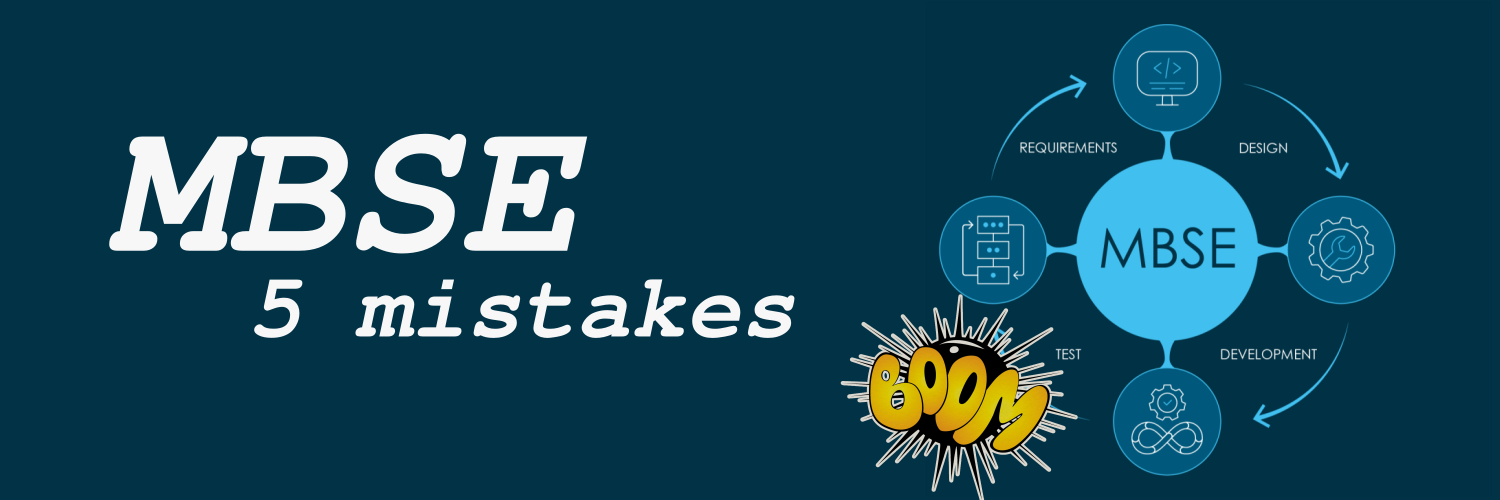Top 8 MBSE Challenges to Avoid in Automotive Engineering

Top 8 things to avoid when starting with Model Based Systems Engineering (MBSE) in Automotive.
Welcome to MBSE Explained, your go-to source for mastering Model-Based Systems Engineering (MBSE) in the automotive world. With nearly five years as a Model-Based Embedded Software Developer and Architect, and the past year and a half as a Model-Based Systems Architect, I’ve seen firsthand the triumphs and pitfalls companies face when adopting MBSE. Drawing from experience across multiple organizations, I can assure you: perfection is rare, but brilliant solutions are within reach. Let’s dive into the top five mistakes to avoid to ensure your MBSE journey in the automotive industry is a success.
Relying Solely on Requirements with Supporting Models
Diving into MBSE? Watch out for this trap: leaning too heavily on traditional requirement-based approaches with models as an afterthought. Without a balanced shift, you risk missing MBSE’s full potential.
- Pitfalls to Avoid: Undefined methodology, inconsistent coding styles, unadapted processes, weak reviews, rushed releases, overcomplicated models, and disjointed toolchains.
- Why It Matters: These missteps can derail your project, especially in fast-paced automotive design.
- Fix It: Embrace MBSE as a holistic approach, addressing each area below to unlock its power.
Skipping a Defined or not Defined Methodology
MBSE can feel like a maze without a clear methodology. Where do pieces fit? How do you split a problem between SYS.2 and SYS.3? How much detail is enough? A solid plan is your compass, tailored to your company’s needs, whether detailed or cutting-edge. Steer clear of half-baked methods, especially from ongoing customer projects.
- Mistake: Bypassing a defined methodology (e.g., INCOSE’s OOSEM or IBM’s Harmony) for an EV converter system’s requirements, architecture, and validation.
- Impact: Teams flounder, creating inconsistent SysML models for converter control or power electronics, sparking chaos and rework.
- Solution: Choose a methodology like OOSEM, document it clearly, and train your team. Start with sharp, high-level models like system context diagrams.
Ignoring a Defined or not Defined Coding Style
We’re wired for coding rules—brackets in loops feel natural. But ask for uniform block widths or vertically aligned executions, and chaos erupts. Switching to models without a style guide can slow you down if they’re unreadable. A jumble of overlapping blocks and lines offers no edge over well-styled code.
- Mistake: Skipping standardized modeling conventions (e.g., naming SysML blocks like “DC_DC_Converter_Control” or aligning activity diagrams).
- Impact: Confused stakeholders misread converter state machines, stalling collaboration and maintenance, especially with tools like AUTOSAR or Simulink.
- Solution: Craft a style guide with naming rules and layouts. Use templates in tools like Cameo Systems Modeler to enforce consistency.
Sticking to Old Processes
Before methodology or style, processes need a makeover. Clinging to document-based workflows (e.g., Word requirements, Excel traceability) misses MBSE’s model-driven strengths.
- Mistake: Using traditional processes instead of adapting for MBSE in converter development.
- Impact: You lose automated traceability and simulation benefits, risking errors in converter-battery interfaces or ISO 26262 delays.
- Solution: Redesign workflows to link SysML models with requirements and verification. Align with the automotive V-model, prioritizing model-based validation.
Skimping on Review Processes
Weak reviews can sink your MBSE efforts. Without rigorous checks, model errors—like faulty converter-motor interfaces—slip through, hitting you hard in testing.
- Mistake: Relying on informal reviews, missing accuracy or alignment with converter requirements (e.g., thermal performance).
- Impact: Undetected flaws lead to costly fixes or safety issues in EV projects.
- Solution: Set up structured reviews with peer checks and automated validation in tools like IBM Rhapsody. Involve cross-functional teams regularly.
Not Allocating Enough Time for Quality Model-Based Development
Time can trip up MBSE success. With years in automotive engineering, I’ve seen teams undervalue the effort to build, validate, and refine models—like for an EV converter system—rushing to meet tight deadlines.
- Mistake: Underestimating time for developing, validating, and refining MBSE models for a solid converter release.
- Impact: Unfinished models lead to unreliable designs (e.g., untested control algorithms), risking performance issues or safety violations like ISO 26262 non-compliance.
- Solution: Plan sufficient time for iterative modeling and testing, using MBSE to front-load effort (e.g., early simulations). Prioritize validated requirement models as milestones.
Over complicating Models
Complexity can derail MBSE efforts. From my years in automotive engineering, I’ve seen teams build overly detailed SysML models—like block definition or activity diagrams—trying to map every converter system detail (electrical, thermal, software, hardware) at once.
- Mistake: Crafting intricate models that tackle all aspects of the converter system in one go.
- Impact: These models turn unmanageable, stalling collaboration and overwhelming teams, particularly in the fast-paced EV development world.
- Solution: Begin with lean, high-level models (e.g., system architecture, key interfaces like DC-DC conversion or CAN bus). Refine them step-by-step based on project stages—concept, design, validation.
Ignoring Toolchain Integration
Disconnected tools can sabotage your MBSE success. With years in automotive engineering, I’ve seen teams overlook integrating MBSE tools like Cameo Systems Modeler or IBM Rhapsody with key players like MATLAB/Simulink, PLECS, or AUTOSAR—especially for EV converter projects.
- Mistake: Neglecting to connect MBSE tools with automotive engineering software.
- Impact: This creates disjointed workflows, forcing manual data transfers that breed errors and slow down converter design validation.
- Solution: Choose MBSE tools that sync with your EV toolchain. Set up data exchange protocols like FMI/FMU for co-simulation and automate traceability across requirements, models, and simulations.
Final Words
Avoid these pitfalls, and you’ll pave the way for MBSE success in automotive innovation. At MBSE Explained, we’re here to simplify systems for smarter EVs—turning challenges into breakthroughs. What’s your biggest MBSE hurdle? Share below and let’s tackle it together!
